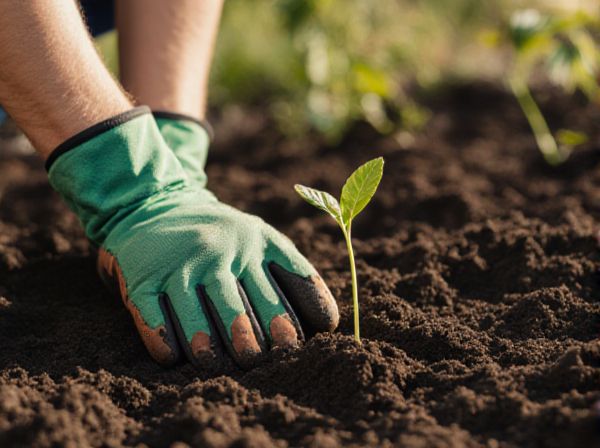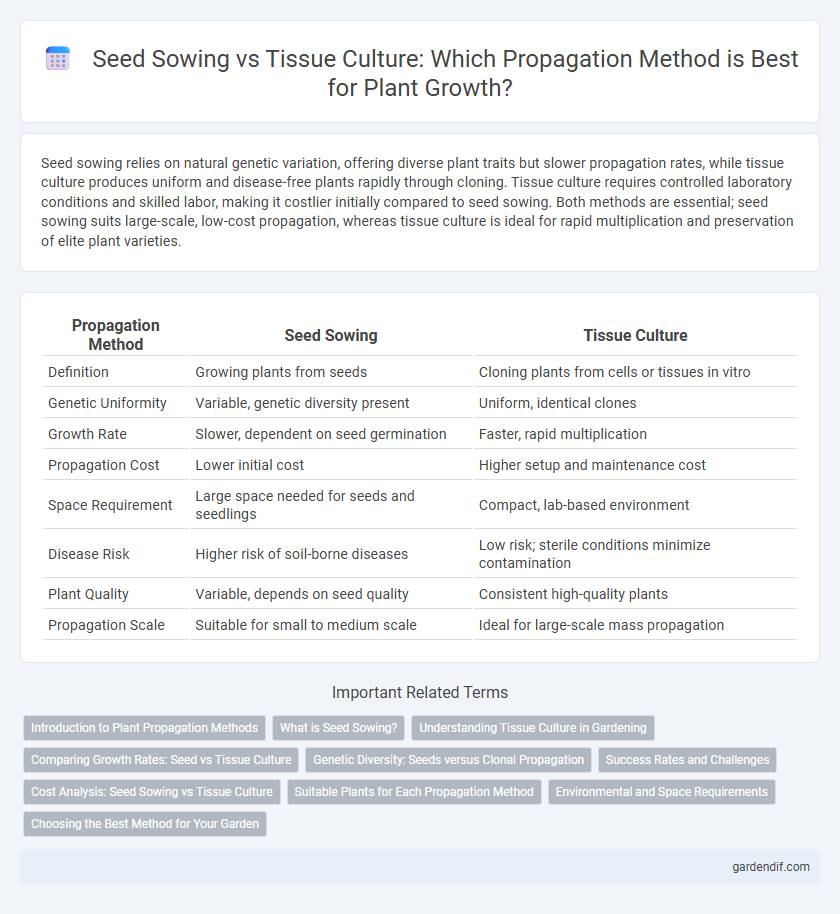
Seed sowing vs tissue culture Illustration
Seed sowing relies on natural genetic variation, offering diverse plant traits but slower propagation rates, while tissue culture produces uniform and disease-free plants rapidly through cloning. Tissue culture requires controlled laboratory conditions and skilled labor, making it costlier initially compared to seed sowing. Both methods are essential; seed sowing suits large-scale, low-cost propagation, whereas tissue culture is ideal for rapid multiplication and preservation of elite plant varieties.
Table of Comparison
| Propagation Method | Seed Sowing | Tissue Culture |
|---|---|---|
| Definition | Growing plants from seeds | Cloning plants from cells or tissues in vitro |
| Genetic Uniformity | Variable, genetic diversity present | Uniform, identical clones |
| Growth Rate | Slower, dependent on seed germination | Faster, rapid multiplication |
| Propagation Cost | Lower initial cost | Higher setup and maintenance cost |
| Space Requirement | Large space needed for seeds and seedlings | Compact, lab-based environment |
| Disease Risk | Higher risk of soil-borne diseases | Low risk; sterile conditions minimize contamination |
| Plant Quality | Variable, depends on seed quality | Consistent high-quality plants |
| Propagation Scale | Suitable for small to medium scale | Ideal for large-scale mass propagation |
Introduction to Plant Propagation Methods
Seed sowing involves planting seeds directly into soil to naturally grow new plants, offering genetic diversity but slower development. Tissue culture is a sophisticated propagation technique that uses sterile laboratory conditions to produce large numbers of genetically identical plants rapidly. Both methods play crucial roles in horticulture, with seed sowing ideal for variety expansion and tissue culture suited for mass propagation and disease-free cultivation.
What is Seed Sowing?
Seed sowing is a traditional propagation method involving planting seeds directly into soil or growing media to initiate germination. This technique relies on natural seed dormancy cycles and environmental conditions such as temperature, moisture, and light for successful sprout development. Seed sowing is cost-effective and maintains genetic diversity but may result in variable growth rates compared to clonal propagation methods like tissue culture.
Understanding Tissue Culture in Gardening
Tissue culture in gardening involves the propagation of plants through the aseptic culture of cells, tissues, or organs under controlled conditions, ensuring rapid multiplication of disease-free and genetically uniform plants. Unlike seed sowing, which depends on sexual reproduction and can result in genetic variability, tissue culture allows for the cloning of plants, preserving desirable traits and accelerating production cycles. This technique is particularly valuable for cultivating rare, endangered, or high-demand plants where consistent quality and quantity are crucial.
Comparing Growth Rates: Seed vs Tissue Culture
Tissue culture enables significantly faster growth rates than traditional seed sowing by providing a controlled, nutrient-rich environment that promotes rapid cell division and plantlet development. Seed propagation relies on natural germination processes, which are slower and more variable due to environmental factors and seed dormancy. Consequently, tissue culture offers accelerated plant multiplication and uniform growth, essential for large-scale horticultural production.
Genetic Diversity: Seeds versus Clonal Propagation
Seed sowing promotes genetic diversity by combining alleles from two parent plants, resulting in offspring with varied traits that enhance adaptability and resilience. Tissue culture, a form of clonal propagation, produces genetically identical plants, ensuring uniformity in crop characteristics but limiting genetic variation. This lack of diversity in tissue-cultured plants can increase vulnerability to pests and diseases compared to seed-grown populations.
Success Rates and Challenges
Seed sowing offers moderate success rates influenced by seed viability, environmental conditions, and genetic variability, often resulting in slower propagation due to germination time. Tissue culture presents higher success rates with rapid, large-scale plant production under controlled sterile conditions, yet it faces challenges such as contamination risk and the need for specialized equipment and expertise. Both methods require careful optimization to maximize plant survival and quality during propagation.
Cost Analysis: Seed Sowing vs Tissue Culture
Seed sowing involves lower initial costs, primarily limited to purchasing seeds and basic soil preparation, making it economically viable for large-scale, low-value crops. Tissue culture requires significant investment in sterile lab facilities, skilled labor, and specialized equipment, driving higher upfront and operational expenses but providing faster propagation and disease-free plants. Long-term cost analysis shows tissue culture can be more cost-effective for high-value, uniform crops due to increased yield and reduced crop loss.
Suitable Plants for Each Propagation Method
Seed sowing is ideal for plants with viable seeds like legumes, grains, and many fruit trees, enabling genetic diversity and robust root development. Tissue culture suits plants that are difficult to propagate by seeds or cuttings, such as orchids, bananas, and certain ornamental shrubs, ensuring rapid multiplication and disease-free clones. Selecting the appropriate propagation method enhances plant survival rates and supports large-scale commercial production efficiently.
Environmental and Space Requirements
Seed sowing requires ample soil space with favorable environmental conditions such as temperature, moisture, and light for successful germination and growth. Tissue culture demands a sterile laboratory environment with controlled humidity, temperature, and light, optimizing space efficiency through vertical stacking of culture vessels. Environmental control in tissue culture allows year-round propagation without seasonal limitations, unlike variable outdoor conditions affecting seed sowing.
Choosing the Best Method for Your Garden
Seed sowing provides genetic diversity and is cost-effective for large-scale propagation, ideal for annuals and species suited to natural growth cycles. Tissue culture ensures disease-free, uniform plants and rapid multiplication, making it preferable for rare or genetically identical specimens. Gardeners should assess factors like plant species, desired quantity, growth speed, and budget to choose the most suitable propagation method.
Seed sowing vs tissue culture Infographic

 gardendif.com
gardendif.com